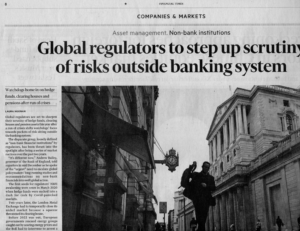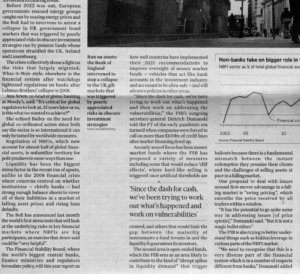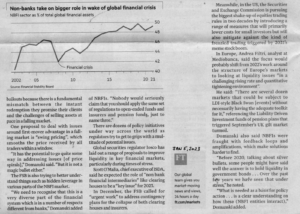Why the Federal Reserve needs a New Plan –
Do you think the Washington post continues to show a right tilt with “opinion” pieces
like this one from investment firms? Really?
Ken
Opinion
Why the Federal Reserve needs a new plan
By Larry Hatheway
February 3, 2023 at 12:36 p.m. EST
https://www.washingtonpost.com/opinions/2023/02/03/fed-policy-inflation-unemployment/
Larry Hatheway is the former chief economist at UBS Investment Bank and GAM Investments. He is co-founder of Jackson Hole Economics, a think tank, and founder of HarborAdvisors, an investment advisory firm.
The Federal Reserve surprised barely anyone by lifting rates a quarter-point this week. But what should worry everyone is that the Fed now seems to be making up policy as it goes along.
With recent economic data throwing some curveballs, it’s important the Fed soon articulate a new strategy for fighting inflation while maintaining high levels of employment.
A year ago, as U.S. inflation began to accelerate, the Fed (and many economists, including me) argued that soaring prices were transitory — the result of supply-and-demand disruptions caused by the covid-19 pandemic and subsequent lockdowns. The Fed reacted too cautiously as prices picked up and was too slow to raise rates.
Within months, inflation raced to 40-year highs, and the Fed was playing catch-up. In less than a year, rates have now jumped 4.5 percentage points, and Fed Chair Jerome H. Powell has warned of the “pain” that would be inflicted on ordinary Americans, an indication that rate hikes would lead to job losses.
The guiding model for this approach is the Phillips Curve — discovered by 1950s economist A.W. Phillips, whose work noted a trade-off between unemployment and wage inflation that could spill over into broader price inflation.
There is an appealing logic to this. Wages and benefits are the single-largest cost for most businesses, so a tight labor market drives costs up and gives rise to inflation. Thus, the best way to fight inflation is to hike interest rates to slow the economy until unemployment rises sufficiently to bring prices back down again.
But this isn’t what has happened. Rates have gone up and inflation has slowed, but the labor market remains tight, despite some layoffs. Even after all of last year’s Fed rate hikes, the unemployment rate announced Friday is at a 54-year low of 3.4 percent. As a result, the Fed looks confused, unsure about what is driving key economic indicators.
So, it looks as if inflation could have been the result of transitory forces after all. Post-covid supply-and-demand problems, rather than the Phillips Curve logic, might have been largely responsible for last year’s price surges. Powell acknowledged this week that the Fed will need to see more data to confirm whether the slowing of price pressures is temporary or longer-lasting. He said that although prices for some components are certainly headed lower, the direction of other prices appears less clear.
The restoration of low inflation without the pain of mass job losses would be welcome, of course. But it would also present a conundrum. If the whole Phillips Curve thesis is in doubt, then the basis for Fed decision making is in doubt, too. And if the labor market doesn’t explain inflation, then what does? The Fed is mandated with managing inflation and employment, so it’s not a good look to be wavering on these key questions.
Without solid underpinnings for the Fed’s analysis and its actions, we’re flying by the seat of our pants, and Fed policy risks making things worse. That is not a small risk. The Fed deals with complex situations but wields only fairly blunt instruments, determining money supply and interest rates. Students of monetary policy history know all too well about the Fed’s egregious policy mistakes in the 1930s and the 1970s, errors that contributed to the depths of the Great Depression and runaway inflation, respectively.
The financial markets reacted positively to this week’s Fed announcement. Stocks and bonds were buoyed by the notion that the worst of the inflation is over and rate rises are coming to an end. But that ignores the deeper problem about the limits of the Fed’s understanding of the economy right now. Until we get a stronger handle on what is driving inflation, the future remains far from certain.
SELECTED COMMENTS
clevidence Feb 3 2023
I would respectfully submit the author has forgot his Macro-economics. There is another major tool in the fight against inflation. Taxes.
The best tool to control inflation would be tax increases on those individuals and corporations with the most disposable income. Wealth accumulation of top earners is at all-time highs and tax rates are at all-time lows. They are unaffected in terms of employment by rate increases and they spend the most money and their demand is less affected by price increases so inflation alone does not cut their spending.
No wonder the traditional rate increase-unemployment model is broken. Demand untethered from cost has fueled it.
But taxes are not something the Fed has any control over and politically, since the donor class is exactly who should be taxed at a higher rate, it will not happen.
The Fed is attempting surgery on the economy with a hammer. There will be needless pain. A responsible economist with a megaphone should at least mention tax increases on those spending the most as a solution.
rad61
We know the cause of inflation – fully 50% of inflation is due to rising corporate profits. Only 8% is due to rising labor costs and the rest is commodities (mainly oil) and supply chain issues.
Companies can no longer raise profits by decreasing the quality of goods, cutting services, outsourcing to countries with cheap labor…..so they are raising prices.
The Fed and Mr. Hatheway completely ignore this cause.
And taxes are absolutely the best tool, not battering the economy into recession with the hammer of interest rates.
Companies and the wealthy are killing our economy.
ronaldsitrioni
Robert Reich has been screaming from the roof tops that this time, inflation is the result of corporate profiteering and the solution is taxes on corporate profits and the wealthiest individuals. He has been arguing for this solution and calling the Fed’s interest hikes wrong for approximately 2 years.
(Edited)
dontblowsmoke @ronaldo And yet not once has the Post solicited a guest opinion from him. He has actual data showing the degree to which market power (consolidated industries) enables price increases beyond additional costs of production. Corporations outright brag during earnings calls about using inflation as a cover to increase profit margins. Heck, Amazon made massive profits during 2020 and 2021, yet raised Prime about 20 percent (I don’t have it so I don’t know the exact figure). You won’t see that mentioned in the Post.
Wage increases are running about 3 percent below inflation, so they can’t be the cause. In fact, REAL wages have gone down.
Could the Post find some opinion writers who aren’t in the corporatocracy?
macielun
2/4/2023.WP. Opinion Why the Federal Reserve needs a new plan.
Let’s be clear. The (devalued) dollar is the financial infrastructure that allows America the unique privilege to print any amount of money without the danger of hyperinflation.
In other words, the dollar makes the US a dominant global superpower. So if the international financial system loses faith in the greenback, bets are off about the future.
mford1
Interest rate adjustment is the principle tool the Fed has to influence inflation. However, 40-60% of inflation is caused by corporate concentration:
https://mattstoller.substack.com/p/corporate-profits-drive-60-of-inflation
and:
https://robertreich.org/post/685804888044765184


